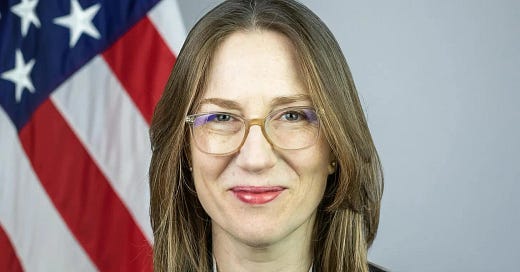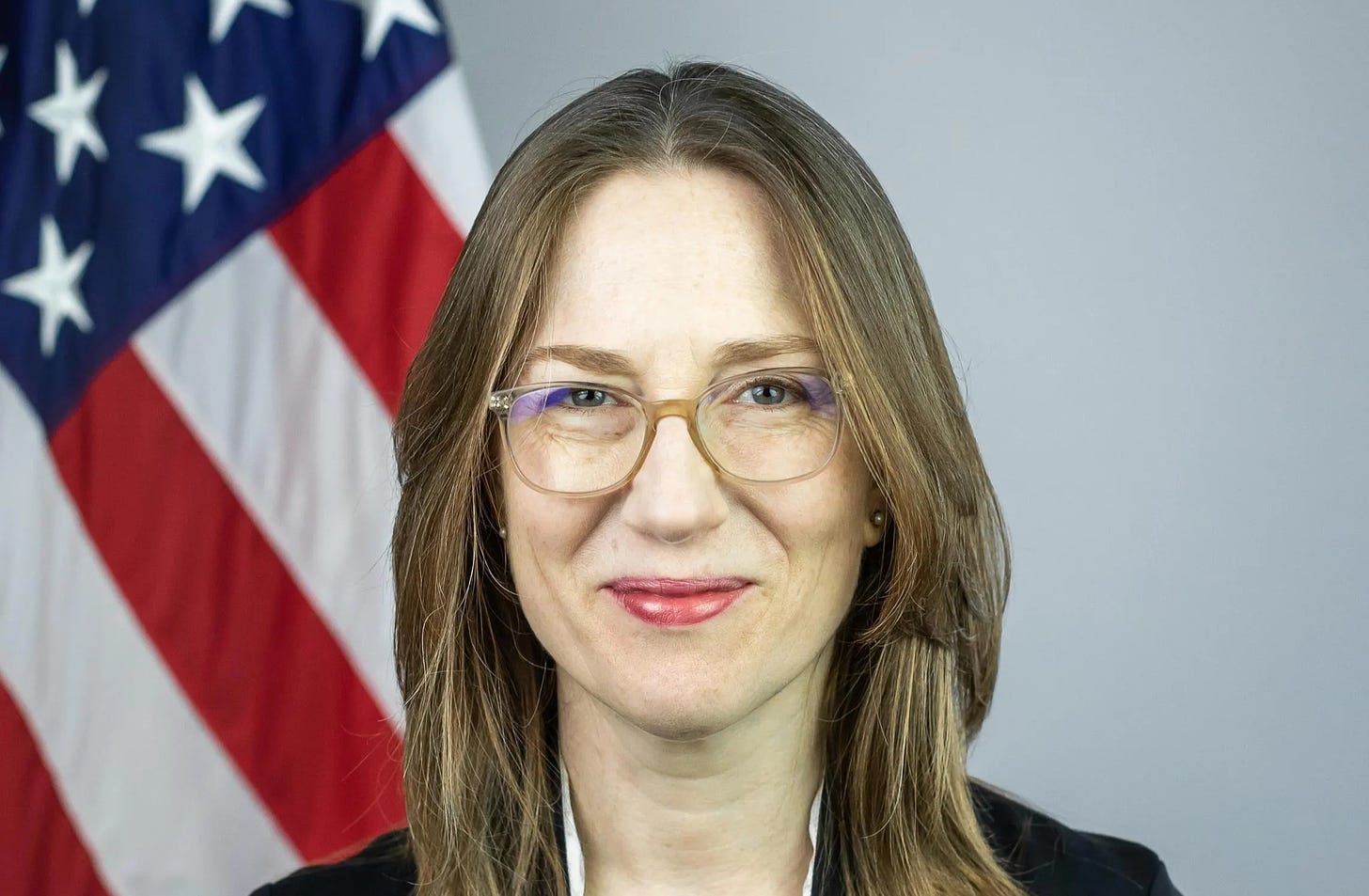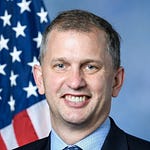In this episode, we explore the Biden administration's ambitious industrial investment strategy with Heather Boushey, a member of the President's Council of Economic Advisors and chief economist for his Invest in America Cabinet.
Text transcript:
David Roberts
All right, then. Hello, everyone. This is Volts for September 18, 2024, "How the Biden investments are changing America." I'm your host, David Roberts. Joe Biden came into office with incredibly narrow majorities in Congress — a handful of votes in the House, and one vote, his vice president's, in the Senate. Yet in policy terms, his tenure has been vigorous and a fairly dramatic change in direction from previous democratic administrations. Democrats learned from the experience of doing too little to stimulate the economy in the wake of the 2008 financial crisis; this time, they spent big on recovery.
They learned from being out-invested by China while they cosplayed "free trade"; this time, they poured money directly into industries important to American security. They learned from leading climate policy with sticks in 2009; this time, they led with carrots. Together, the three big democratic legislative accomplishments, the Inflation Reduction Act, the Bipartisan Infrastructure Law, and the CHIPS Act (or uncles, Ira, Bill, and Chip, to friends) — have invested billions and triggered hundreds of billions more in private investment across the US. What has it all accomplished so far?
To discuss that, I'm thrilled to talk with someone who has been at the heart of this investment-led strategy: Heather Boushey, a member of President Biden's Council of Economic Advisors and the chief economist for his Invest in America Cabinet. Boushey is a longtime Washington, DC, veteran who has worked as an economist primarily focused on inequality at the Washington Center for Equitable Growth (which she co-founded), the Center for American Progress, and the Center for Economic and Policy Research, during which time she's written two books and edited another.
She was the chief economist for Hillary Clinton's presidential transition team. For the past four years, she's been advising Biden. We are going to discuss the Biden administration's investment approach, its effects on the ground, and so much more. I could not be more honored and excited about this.
With no further ado, Heather Boushey, welcome to Volts. Thank you so much for coming.
Heather Boushey
Oh, it's such an honor to be on one of my favorite podcasts.
David Roberts
You're a credentialed economist, Heather. You've served all sorts of distinguished institutions. I feel like you're slumming.
Heather Boushey
But I learned so much about clean energy from you and your guests. I'm so excited to be here today.
David Roberts
Well, this is awesome. So, I want to start at the big picture level, the theoretical level. There's been lots of articles written, lots of talk in the last several years about the supposed end of neoliberalism. There have been Biden officials who have said pretty explicitly in speeches — Brian Deese, Jake Sullivan, et cetera — pretty explicitly that they're leaving neoliberalism behind. I sort of would love to just get your thoughts on how seriously to take this talk of a sort of break. You know, do you see this — because you have served in Washington, DC, and in and around Democratic administrations before, so I'm just curious, from your perspective — do you see this as, as really a break, a new paradigm, or is it something like an evolution of the sort of neoliberal paradigm? Just how big of a break do you see the Biden approach from previous democratic administrations or even, like, Washington consensus?
Heather Boushey
I'm going to be such an economist in this answer, because I'm going to say, " on the one hand, on the other hand."
David Roberts
What is it about economists and their hands?
Heather Boushey
Yeah, well, so on the one hand, presidents, lots of them, talk about what they're going to do to grow the middle class. They have long dealt with different kinds of economic crises. When the Biden-Harris administration came in, of course, we were facing a series of crises: the pandemic and the ensuing recession and all of the challenges that that brought alongside all of these structural challenges that had been there all along. In many ways, the pandemic really unmasked and made so apparent to us all the fragility of the supply chain that we developed around the world. The ways that the existential crisis of climate change was leading to economic challenges in the here and now. And now, the pandemic was sort of uncovering how the global economy could make some of those climate challenges even more pressing.
And, of course, longstanding issues around equity, longstanding inability to address inequities across places across the country. So, you had all of these challenges, and again, presidents come in and they say, "I'm going to create jobs and we're going to support the middle class." But Joe Biden did a number of really different things, and one of them was that when he came in and put forward his agenda, he made a deep commitment to working across the aisle and doing things in a bipartisan way. But he also made a commitment to making sure that in everything he did, everything that he, along with Kamala Harris, did was actually supporting and growing and building the middle class and being willing to look at what we've gotten right and what we've gotten wrong in the past.
And so, when I think about how he approached climate, there's a big shift with previous thinking both in the United States and abroad in how to approach the challenge of climate change. And as you noted in your intro, this is about not so much thinking about the sticks, but thinking about the carrots. I actually don't really think about it so much that way. But I think about it — I'm going to throw a different metaphor out there, not about donkeys, but about food, which is that I often think of the challenge that we have with clean energy as we have this economy, and it's sitting on a platter that's held up by a bunch of pillars.
And those pillars are our energy system. It's a system, it isn't one thing. It's a whole bunch of different things. And of course, that's grounded in fossil fuels. We need to move over to an economy grounded on a set of pillars around a new clean energy system, both domestically and globally, and all the things that are entailed in that. We want to move our economy over from one platter to the other as smoothly as possible without losing too much of that cake. I think of it as a big cake, this economy, you want to be very careful with it.
So, it's not so much just about the carrots and sticks. It's about how are you shifting the economy? Where are people, where are businesses, where are communities, where are families? And what do we need to do to support them to make that shift?
David Roberts
I mean, one of the sort of characteristics of neoliberalism, this kind of a fuzzy, stupid word, but one of the ways people characterize it, is deference to the markets. What is the market going to produce for us? What sort of economy is it going to give us? Just this whole approach that you're talking about, like what kind of economy do we want? Let's be intentional about constructing an economy in a sort of intentional, forward-looking, proactive way. That in itself seems like a bit of a break.
Heather Boushey
That's the break right there. It's acknowledging that markets don't always deliver optimal outcomes. But, on the other hand, markets are amazing. Over the course of this podcast, we're going to talk about how we're using markets, how we're tapping into the best of what a market economy can deliver. And yet, you need to make sure that the things that you need as a society are there. And again, it's something that we all saw with our own eyes and we experienced during the pandemic when the things that we needed just weren't available. And we're like, "Oh, wow, these supply chains, they're fragile."
When a factory closes down in Malaysia, that means I can't get the thing that I need. It means that maybe the car I want to buy is more expensive because that factory had something to do with semiconductors or something along that supply chain. Or, you couldn't get the respirators or the face masks that we needed. There were these real-world challenges, and I think we had forgotten that the economy is about giving us the things that we need to live. And energy is so important to everything that we do. It's in everything. We have to be intentional about the kind of economy we're going to create as we build a clean energy economy.
So, it's not that we're not using market tools, but it is that we are being intentional there. And of course, the president has been intentional about a set of industries that he thought were very important.
David Roberts
We're definitely going to get into that. But this proactive thinking about the economy is a new thing, I think, a little bit, for the Democratic establishment, and it's sort of like they're all kind of groping their way forward a little bit. It's a new way of thinking about this stuff. So let's just start with some big picture numbers. I think there are a couple of websites now sort of tracking the totals, sort of the amount that's been invested in the wake of the three big bills. So, talk a little bit about that, the big picture, sort of like how much investment has this catalyzed so far?
Heather Boushey
Well, so far, according to the invest.gov website, which is the one that we've been hosting here at the White House, we have seen $910 billion in announced investments all across the country in semiconductors, clean energy, manufacturing, batteries and EVs, bio-manufacturing, heavy industry, and clean power. So, $910 billion. That is remarkable. But let me be very, very clear what that means. That is announced investments. That is a business saying, "Hey, I got a plan. Here's what I'm going to do. I'm super excited about it. I want to tell you about it." Okay, that's one that's super important.
But what we have been doing is saying, "Okay, is that actually being followed up by action? And what does that action look like?" And so, we have been tracking what investments are we seeing coming through our regularly produced data series, a lot of it coming from the Bureau of Economic Analysis or the Bureau of Labor Statistics. And what we've seen is alongside these announced investments, firms are following that up with money, shovels in the ground, to build out new manufacturing. This number has skyrocketed since the passage of the CHIPS and Science Act and the Inflation Reduction Act in August of 2022.
And we've actually now had six historic quarters of investment in the construction of private manufacturing facilities. Three of those quarters were the biggest, going back to 1956. The other three were historic, going back to the 1970s or '80s. But when you look at a visual of this and you see this sustained investment in manufacturing, that's where you go, "Wow." So, these announcements are being followed up, and then we've seen this historic number of people being employed as construction workers. We have new data out on people being hired in the clean energy sectors as part of our economy.
Jobs actually in clean energy are outpacing job growth in the economy overall. So, you're starting to see a lot of indications at the macro level that, wow, something is really changing.
David Roberts
Trey, I wanted to ask about that specifically because one problem with these discussions, which I'm sure you're familiar with as an economist, is just that the US economy is so big, it's a trillion-dollar economy. So, we just have these discussions where giant numbers are flying around all over the place, and I don't know that people really have a great way to contextualize them. So, to me, $900 billion of planned investment sounds big. It sounds like a big number. But I want to think macroeconomically, are the amounts of investment we're talking about big enough that they're going to show up in macroeconomic results, or are they just sort of happy individual stories? But are we changing structurally, the US economy here?
Heather Boushey
Yes. So, a couple of answers here. Three separate kinds of answers. So, one, that number that I was just stating about the investment in new manufacturing facilities as a share of GDP, that investment for some of those past six quarters has been larger than it's ever been, going back to the 1950s when we started that data. So, in terms of showing up in the data, that's a wow. Right? That is a big, like, wow. We've never had so much of US investment in a single quarter be as big in the construction of new manufacturing facilities.
David Roberts
Yeah, and of course, like the post-war period was known for its investment, let's just say.
Heather Boushey
Yeah, so that's incredible. So that's one. But I actually think you've tapped into something really important, which is that this isn't really, I mean, there's a macroeconomic story here, and we can talk about all those numbers, but this is a story about what is happening in places all across the country. This is about a new manufacturing plant being opened in a community and what that means for that community, what kinds of jobs it's creating, what kinds of opportunity it's creating. And it's happening all across the country. And that's a hard story for sort of national level journalists to tell because it's very tactile, very detailed.
I've actually been able to travel across the country. So far, I've been to eleven states over the past few months, and I've been able to see some of these with my own eyes and talk to the business folks, talk to union leaders, talk to the economic development folks, and you see the real difference that this is making in a single community. That's hard to see — we do see it in the macro data, I want to be very clear. We've had this strong growth, we've had this recovery that's been kind of like an Energizer bunny: It just keeps going and going, which has been fantastic.
We've seen that kind of success at the national level. But to truly understand the transformation and how we are building out these technologies, you have to look at what's happening in real places.
David Roberts
Let's talk a little bit about the kind of tools you're using or the tools the Biden administration is using. Obviously, the high-profile investments are the tax credits. I think this is something everybody has heard about. There are clean energy tax credits, manufacturing tax credits, and tax credits out the wazoo. Maybe just talk a little bit about the other. Because the headline here is that the Biden administration is using a whole-of-government approach to these things. That's one of the things that's supposed to set it apart; it's approaching this climate thing in the clean energy transition from a whole-of-government approach.
So, just maybe, talk about some of the tools in the toolbox here. What kinds of things are you doing to push investment to particular places?
Heather Boushey
Yeah, it's a great question. So, we are investing along the full scope of the innovation to commercialization pipeline. We are thinking about, "Okay, well, so we know we need this clean energy economy." We know that there are dozens. You know, by my count, we're investing in about 37 different industries in clean energy. And the Department of — yeah, it's exciting — but the Department of Energy has long been investing in the research and development and the innovation stage of clean energy. And now we're moving into those other phases, the demonstration, the deployment, getting to commercialization at scale. And we are investing on both the supply side and the demand side.
What does that mean? So, you know, you have ongoing programs that are thinking about the R&D aspects, and we've ramped up different programs to help get to that first prototype, that first of a kind production that needs to happen. You've got the Loans Programs Office out there, really helping show capital, show the financial sector, like, "Hey, this is something that you can invest in." So it's like it isn't just in the imagination of the entrepreneur saying, "Hey, I know I can do this." The government is coming in and saying, "Hey, let's actually make this happen." And then that'll help crowd in that private capital.
David Roberts
I just want to make a note of this in terms of breaks from previous Democratic thinking. You talk to the market people and they're like, "Okay, we can have a little public spending on the front end of the industrial cycle, and R&D." Even the libertarians will say, "Yeah, we can spend a little public money on R&D." But I think what we found is like R&D push is not enough to get you all the way to market, right? There's all these sort of phases of development of industries and this sort of holistic approach to guiding industries through all those particular phases. I feel like that's new.
Heather Boushey
It's new. And it's so important because we need to do this as quickly as possible, right? Taking a step back, you look at the data and you look at how much money experts estimate we need to invest in clean energy technologies. It's not just public money. Most of it should be private money, right? These are new businesses, new industries. They're going to be competitive. They're going to be the industries that power our world for generations to come. But we don't have the luxury of letting that happen on whatever timescale folks might want to do it. We need to do it quickly.
David Roberts
I hear the voices of my lefty friends in my head telling me to ask this question. So, one thing you might say is: if we know we need these particular industries and we know we're on a very strict time schedule, why rely on private capital? Why not more public ownership? Why not have the federal government stomp in and just do some of this stuff brute force, rather than trying to sort of lure private capital into doing it? This is a big philosophical question, but I'm very curious about your thoughts.
Heather Boushey
No, it's a great question. We all should be doing what we do best. It's like Management 101. You want people with the right skills and talents in the right roles. And what we know is that American capitalists are really good at what they do. We know that we've got a lot of entrepreneurs out there, a lot of good ideas out there. Again, as I've been traveling, I've had the opportunity to meet with some of these folks at the very cutting edge, like setting up — I actually got to go to downtown Seattle where they're building a factory.
David Roberts
Is it the jet fuels, the clean — ?
Heather Boushey
No, it's for mining. It's a huge battery factory.
David Roberts
The big mining vehicles? Yes, I got invited to that. I didn't get to go.
Heather Boushey
Incredible. So, this entrepreneur, that is the human, that should be him and his team, those are the people that should be making those investments and building that to scale. What they need is the kind of economic climate, the kinds of policy support that will allow them to succeed. Right. Or that will at least make it possible for them to succeed. They're the ones that are going to. They have to do all the work and make all those decisions. Jigar Shah and John Podesta, they often talk about this being "government enabled and private sector led." I think it's really important to remember that we're not going to get there faster by taking everybody and moving them to different parts of the team, different roles.
You want people to be doing what they already do best and tap into that energy and enthusiasm, because that's how you're going to build and build fast.
David Roberts
Let's move to one aspect of this that I find super interesting and also, I feel like is a little bit of a break from an administration's past and also really is kind of at the core of all this, which is sort of the geographic aspect of this. So again, you know, if you're just a market person, you might just say, "We want, you know, X industry well put in some sort of agnostic support for it. And wherever it happens, it happens. Wherever the market decides it's needed is fine." You're being more intentional than that, I think, about trying to channel investments to particular geographies, to particular places, particular communities.
So, I'd like you to talk a little bit about, sort of, what does that look policy-wise? Like, how do you do that? Because, in some sense, if you just say, "I'm going to give you a solar manufacturing tax credit," in some sense, you're at the mercy of the entrepreneurs. Like, if they want to set up their factory in Poughkeepsie, you send the tax credits to Poughkeepsie. You don't have much control over where they put their factory. So, what tools do you have to channel investments to particular geographies, and how do you choose those geographies?
Heather Boushey
So, here's a hypothesis: future scholars will discover that this is one of the truly genius things that the policymakers did as a part of all of this. We have all these different tax credits, tax credits for production of clean energy, tax credits for investment. And if you want to go and get those tax credits, you can get some tax credit if you just do the production or you do the investment. But if you do it in a way that is going to be even more beneficial for the economy and communities, if you make that investment in a low and moderate-income community, or you make that investment in an energy community that's going to need that investment, or if you use apprenticeships, registered apprenticeships, or pay prevailing wages, the tax credit gets bigger.
And that is, it's such a simple idea because it says, "We'll give you something if you want to make the investment," but if you do it in this way that we know, and we know from a lot of empirical evidence and research, that you're going to get a bigger bang for the buck. If you are investing in places that need it most, you're going to have that labor supply there who's super excited to get those jobs. Maybe more capacity, maybe there'll be empty factories that you could use. A whole bunch of good reasons to think about this as a smart policy. And what is incredible is that such a simple idea, and it's working. Right now, again, we're at the beginning phases —
David Roberts
Just for the policy nerds. Like, one of the big dilemmas here is, you can only pass bills through reconciliation. We don't have to go through this whole thing, but like you say, you're stuck basically with the tax code. And what this is, is a way of getting some kind of a simulation of regulation almost into the tax code.
Heather Boushey
But, I would actually say, David, it is, I think, more elegant than that. That's maybe what I thought at the very beginning, "Oh, this is second best." But I actually think that, because, again, you're letting markets do what they do best: We're not telling the entrepreneur or the business owner where to put their factory. They still have to do all the siting. They still have to find the best place to do it. They still need to make a decision that they think is going to work for their business. But we're putting a little bit of our thumb on the scale to say, "Hey, why don't you look at these other places that maybe you wouldn't have thought of," right?
So, what you see are businesses saying, "Hey, this is actually an opportunity for me to invest in this rural community." And what — you know, again, as I've traveled the country and met with people, I was just in Syracuse and talking to these local business owners who are doing manufacturing of fiber optic cables. They've been there for a long time. They wanted to invest in that community. Our policies made it possible for them to do so in a way where they can see a path to viability. Yes. Doing it through the tax code, maybe, like, "Oh, no, it's not...".
But what it did is it allowed markets to do what they do best. And as a result, we are seeing the majority of these new investments, the new announced investments, are going to communities where income is less than the median around the country where folks are less likely to have a college degree. And that means that that is going to help us be a country that can again start growing together, rather than a country that for so many decades has been growing apart. And that is a deep structural change that is so exciting to see from a simple set of policies.
David Roberts
So you're not directly controlling where investments go. You're offering these sort of weighted tax credits. And so, the investments are sort of distributing themselves according to kind of market logic. Are they going where you want to see them going? Do you know what I mean? Is it simulating what you might have engineered if you had told them where to go? Do you know what I mean? Are they distributing themselves in a way that is meeting your goals?
Heather Boushey
A 100%. I think it is definitely meeting the goals, and it has the advantage of, again, being private sector-led. When I look at this map and I'm like, "Wow, these investments are happening all across the country." They're happening in places that voted for President Biden and places that did not. It is truly a policy that is benefiting all of America.
David Roberts
But not evenly distributed, Heather. Now, let's —
Heather Boushey
It's a big country.
David Roberts
Yeah, I mean, they're concentrating. The investments are being concentrated in the Southeast and Midwest in precisely those areas. Like, this is something I've said this phrase so many times to so many people, but, like, these are precisely the places that everybody has been angst-ridden about for decades now that were hollowed out by globalization, lost their manufacturing, et cetera, et cetera, got economically resentful, reactionary backlash, et cetera, et cetera. We're all familiar with the politics of the last several decades. The investments really are going to those places which we should note, like, is good economically. But also, it's like, one twist of this is that I think I heard most recently, the figure is it's basically four to one Republican districts versus Democratic districts.
So, like most, you could even say the vast bulk of these investments are going to red areas of the country. Areas of the country controlled by your political opponents. And I just, I just want that on the record. We just lived through Trump, you know, saying, "I'll send help for the pandemic to states that I like and not to states I don't like." You know, just the crudest sort of tribalism. And I just want it on the record here that Democrats have engineered billions of dollars of investments in Republican areas of the country. It just can't be repeated enough.
Heather Boushey
Well, it can't be repeated enough because fundamentally, this is about when the President has said time and time again he wants to build an economy from the middle out and wants to see more of these comeback communities. This is what it looks like. This is what it means to think about the US as an economy where, again, we want to have communities across the country growing together. We want to create opportunity all across the country. And, I mean, I think it's just enormously exciting to see that. And it's exciting to also think about what the ramifications of that will be.
David Roberts
Oh, yes, I've thought quite a bit about the ramifications.
Heather Boushey
Yeah, if you have less inequality across the country, you know, maybe that will help. I mean, that will certainly help. People feel like they're keeping up, make it easier to move across places because you won't have these huge gaps in costs and affordability, right? And I think it also will make these policies much more durable, right? As people are benefiting from them in a variety of communities and seeing, "Wow, these are —" you know, we're creating good jobs. As it turns out, we are now seeing that jobs in clean energy are increasingly likely to be unionized.
And that's great, right? And so, you're seeing them create these good jobs, revitalizing communities and those real benefits that'll help people see that actually building this clean energy economy can be fantastic and it can be good for US competitiveness, and it can be good for my community and my family and those jobs. And that's exactly what we wanted.
David Roberts
We'll see if they draw those conclusions. We'll see. It's early yet. One other question about these areas, speaking about them generically, obviously, there's tons of variation from place to place, but the basic kind of area that's going to have been hollowed out by globalization, let's say, has been disinvested in for decades. We're seeing some investment come to those places, a big investment. But I'm just curious. I mean, it's early yet, right? It's only two years since these things passed. It's crazy the amount of stuff that's happened in those two years, but still, we're early yet in the process.
I'm just concerned. What do economists know about — it's one thing to just sort of drop some investment on a community like they won the lottery. It's obviously going to help. They're obviously going to be happy about it. But what does it take to turn communities around in a long-term way? Do you know what I mean? Do you think about that in terms of it's one thing to build a big factory in a place, but that in itself might not be enough. Over time, you want to start thinking about conglomerations and agglomerations and the structural shifts that will help these places prosper in a more enduring, long-term way.
How do you think about the difference between short-term relief versus real long-term structural turning these communities around?
Heather Boushey
So, one of the things that you see, and we have certainly in the administration done a lot of work to promote this, but this is a partnership, right? A factory is just, it doesn't exist in isolation. You need a community around it. You know, it's got to be connected to the power grid. There's got to be roads. You know, it's all of those things. You need workers and, you know, maybe engineers and, you know, so you need workers at different levels. You know, how are you going to recruit them and retain them? What kinds of jobs are you creating?
Are those going to be good jobs? Do those workers have places to live? Are there good schools? And so, yeah, there's a whole bunch of different questions. We were at a business roundtable in upstate New York, in Syracuse with the Empire State Development Corporation. I'm not sure it's called corporation, but their economic development agency and then the folks at the community college and the business leaders who are seeing this influx of investment coming into their community, and they are thinking, "Okay, the shovels are just going in the ground now to build these factories that are going to change our community. What do we need to be doing to make sure that the community is ready, to make sure that this really works for us?" And what you hear from them is, "We worked so long to be able to build the kind of community that would bring these kinds of investments to us." So they're excited for the challenge, but of course, they need support. And we've created these workforce hubs across the country, and then there's other kinds of supports. But you have to have that connective tissue. And it's also why in so many of the things that we've done through the Bipartisan Infrastructure Law, CHIPS and Science Act, and the Inflation Reduction Act, we've been very intentional that these investments have to work for communities because ultimately that factory isn't going to get built if the community is fighting it.
So, you may as well start from the get-go and think about that. It has to create good jobs. You have to think about, "Wow, if you're going to be hiring all of these people, how are you thinking about childcare or other services?" So, we also really encouraged businesses to think about that as they were making these new investments. And certainly, we've done our part to try to elevate those issues. So, I've seen a lot of excitement and enthusiasm as I've traveled the country.
David Roberts
It seems like it's kind of the perfect opportunity for states to step in. Are state governments working in a complementary way with you to help flesh this out?
Heather Boushey
Certainly, I mean, that's what I've seen. I've met mostly with local development folks, but also with some both national and state level elected representatives who are there to do their part. They see this transformation, what it can mean for their community, but they have to take advantage of it, and they have to make sure it's done right. So, they really are the boots on the ground. It's so connected, right? I know that — again, when I listen to your podcast, a lot of it's about the specific technologies in energy, right? But building that clean energy economy is also about all the other things we need to do.
And so, I've ended up traveling to a lot of airports, not just to fly through them, but to stop and talk to people about the investments that we're making in those transportation networks. And seeing the enthusiasm for making clean energy investments at those airports. We were recently at Muhammad Ali Airport in Louisville where they have put in a geothermal system to power the airport.
David Roberts
Love it.
Heather Boushey
Love it. And it has a dual purpose because it also serves as a parking lot for all the little jets that come in for when they have Derby. They were like, "Oh, now we have this great parking lot for Derby, and we have this amazing geothermal system," and they're going around and telling other airports around the country how to do that.
But that enthusiasm, that excitement about what this national policy has made possible for them. You see this pent-up demand; for so long, infrastructure was the butt of so many jokes as we just couldn't get it across the finish line. So, you see that. But that also is then empowering, no pun intended, the clean energy investments that we're making at the same time. And what I see is communities connecting those dots and not seeing them as separate, but seeing them as how they're going to grow and develop their communities.
David Roberts
Is it awkward at all for some of these officials to say, "Hey, look at this cool new thing that I voted against coming to you from the party that I have told you is full of satanic pedophiles?" Is that awkwardness an impediment at all? Or do you find that that kind of like, drops away when you get closer to the local level?
Heather Boushey
So, I can only speak personally on this one, and it has been incredible to me. I'm so proud to work for a president and vice president who believe in governing for all of America and have been so delighted at the reception. I mean, oh, I'm a girl from the Seattle area. I think I definitely, and I work for, you know, a Democratic president. But, you know, I go out there and the joy and the enthusiasm that I have been greeted with from people from, I know, across the political spectrum but who are focused on their communities. And that's what brings people together, that, you know, we have real problems to solve.
And it's always about creating good jobs, creating a good quality of life in their community. And we're giving communities the tools and the resources to do that. And we're giving the private sector the incentive to invest here in the United States, building things that matter that people are excited about.
David Roberts
Well, I have kind of a combination jobs/security question. So, the whole idea here is that investment is — we have these supply chain worries, right? These supply chain difficulties we ran into during the pandemic has sort of, as you say, revealed that our supply chains are somewhat brittle. And furthermore, the supply chains for the technologies we're talking about being at the heart of the 21st century are dominated almost entirely by China right now. So, that worry is driving a lot of this. And so there's been investment across the supply chain. But I feel like what we're seeing is mostly the results are mostly jobs and factories and stuff kind of toward the upper end of the supply chain, assembling battery cells or assembling vehicles, and not as much at what you might call the lower end, sort of like mining the materials and doing the sort of processing of raw materials. That, I feel like, we have not seen as much movement on as we've seen at the high end of the supply chain.
And, I just wonder, are you cognizant of that? Do you worry about it? Because, in a sense, if there's one stage of the supply chain that China dominates, they might as well dominate the whole thing, because if they just stop sending us materials, it doesn't matter if we have cell assembly factories or whatever, if we can't get the materials. I'm just curious how you think about the kinds of jobs in factories that are coming, whether they're as comprehensively across the supply chain as you want, and whether you worry about that at all.
Heather Boushey
Well, these are definitely things that keep me up at night. And, I mean, I'm an economist, and one of the things that you learn in econ graduate school is that there are a lot of problems with monopolies. And, you know, that's a basic fundamental. And here in the United States, it's long been a fundamental role of government to make sure that markets are fair and competitive, right? That they are not dominated by one player. Because when that happens, they have all this market power and they can squeeze out the competition, they can limit new ideas, and they kind of have you over a barrel.
David Roberts
They don't just have you over an economic barrel, right?
Heather Boushey
Oh, yeah.
David Roberts
It's security, it's economic —
Heather Boushey
It's all the things.
David Roberts
Yeah. So, these are all mixed together, these kinds of security.
Heather Boushey
Yeah, well, especially when, I mean, fundamentally, stable access to affordable energy has always been a national security issue. Right. If you can't get it, then you can't power anything. That's just so basic and fundamental given the kinds of economies we have. But then, of course, when you think about technologies like semiconductors and all the electronics and how much potential there is for dual use and tracking and all of the other things, of course, these are issues that are front and center. You have to think about that full supply chain. And it can't be, it's not good for the United States, it's not good for our friends and allies.
It's probably not good for the global economy to have monopoly power in the way that has these bottlenecks and key parts of the clean energy supply chain. And it also, at the same time, we saw again during the pandemic and a variety of other cases that we need supply chains that are resilient. Markets don't always reward resiliency. You only need resiliency when you need it. And maybe you make enough room for it. But if you don't have it, depending on how a firm is integrated, who's paying the cost of that lack of resiliency is a big question.
So, you have two things going on at once, which is how do you make sure that you have resiliency, which means you want to source from different places, but at the same time, you want that to be competitive and open and you don't want that to be dominated? Then there's a third issue, which you just talked about, the supply chains, which is, again, I'm going to go back to my cake metaphor, moving it across these two platters. You have to have enough demand to induce supply, right? Businesses need to know, like, "If I build this stuff, is there somebody going to buy it?"
Right. So, when you think about those supply chains, we are building them out and creating new opportunities for new businesses to say, "Wow, there's going to be this new industry here in the United States or this new industry out there in the global economy. Now, I can go in and I can raise the capital to go in and create that supply to do that production." So, there are some urgent issues. We need to unpack this monopoly that China has on particular parts of that supply chain. We need to really be thinking about resiliency, but there are timing issues.
And so, that's the hardest part, is to think through everyone having kind of enough foresight to know, "Here's our goals, here's where we're going." And because of BIL, CHIPS, and IRA or three uncles or three cousins — I think they're still toddlers. So, I think of them more as like, you know, the chipmunk kind of like little toddler types. They're going to grow up and they're going to be great. But, you know, we have, we've given the private sector all of these tools and all these new resources. But yes, we do need to continue to be thinking strategically.
What else do we need to do to make sure that those supply chains are resilient and that they're creating economic opportunity and that they are inducing enough investment to make the changes that we need to see in our energy systems?
David Roberts
Well, then I return to the original question then: Do you think we're doing enough on the lower end of the supply chain? And if not, what tools or how do you think about how to intervene to try to induce some of that?
Heather Boushey
I'll say "yes," because the fact that we can have a conversation about it means that we are aware of the problem. And certainly, policymakers, folks across government are certainly thinking about all those issues. And we are certainly in active conversations with our friends and partners around the world around how we think about the critical minerals conversations and all of that. So certainly, this is all on the table and being worked through, and it's happening in real time. And I think that's what's both challenging to kind of watch. And I just, I wanted to say this a couple of minutes ago, so I pause and say it here: We have to keep reminding ourselves that what we're building is a system and the problem with systems and the way that our markets work, when you were asking where did the administration make really big changes, it was acknowledging that this is a system and that any one actor can't make the change on their own, right? It's hard for me to buy — I mean, I have an electric vehicle, okay, but the challenge is knowing, you know, like I have to, like you have to plan your routes carefully still, because there's not enough charging stations yet. We're building those.
But that's a systems problem. I can't solve that system-wide problem of the EV charging network. It's that chicken and egg.
David Roberts
Legendarily difficult to solve systemic problems. Right. Because you're trying to move one piece, and you don't necessarily know if the other pieces will move also. Like, it's a lot of things going on at once.
Heather Boushey
Yeah, which makes it exciting.
David Roberts
That's one word for it. But back on this minerals and supply chain security thing, I have questions about this. If you go look at the numbers, it's striking the degree to which China dominates these things. Like minerals, processing of minerals. Just like 90%, 95%, 99%. Obviously, I think if China controls 99% of some key bit of the supply chain, I think it's very intuitive for people why that's a problem, right? Because you don't even have to sort of speculate about any nefarious intent on China's part. Like if they just got hit with the wrong kind of weather systems or whatever, you know, something disrupted their supply, all of a sudden, the rest of the world is without.
But I'm just curious, like, nobody's talking about spending the kind of money it would take for us to create a complete supply chain here such that we didn't need China. Right? Like, that's... I don't think anybody's targeting that. You know, there's no one answer to this. But, like, how much of the supply chain do we need to wrest away from China for us to feel secure, for us to feel like we've added some resilience, you know what I mean? Like five? Is that 5%? Is that 10%? You know, sort of. How do you think about how much of the supply chain needs to be wrested away from China and spread more around the world?
Heather Boushey
Well, that is a great question. And I think it comes back to this question of resiliency. I mean, clearly, 90% is too high. Right. But how far do you need to pull that down? It's going to come down to a few things. One is that you do need a diversity of suppliers. You need to unconcentrate that, and you need to make sure that wherever you are supplying from, you're able to access enough of whatever that thing you need, be it the critical mineral that, you know, the parts for the batteries or whatever it is, that you can access enough to actually meet your domestic needs.
So, that doesn't mean that you have to produce it all here in the United States or all in one other country. But can you look out and say, "Wow, well, we have enough different kinds of suppliers that seem stable and where no one has enough market power to really dominate the prices or the quantities that are being supplied in the market." So, I think that is what we're looking for. And in fact, the White House has done, along with the agencies, a series of reports and work around supply chain resiliency. There was the 100 days supply chain reports and all this work that was done.
That really does put some fine-tuned numbers on specific parts of the economy. How to think about that? But I think when you zoom out for this conversation to the more macro picture, it really is, do you have that resiliency and are you able to access what you need? I think one of the opportunities here is because we all know that we need to make so much investment to meet our clean energy goals. This is the moment. This today, right now, is the moment to be having this conversation and to be making these investments so that we aren't stuck here a few years from now, continually facing this monopolized market for really critical technologies that the whole world is going to need.
David Roberts
Yeah, it's the old best time to plant a tree cliche, right?
Heather Boushey
I'm going to say it's today. Yeah.
David Roberts
Let me ask about this. It seems like on the clean energy production side, our manufacturing side, what we've seen in the last two years is an almost unmixed positive story. It's just amazing. There's tons of investment in manufacturing, tons of new factories, etcetera, etcetera. Where things are not as smooth and happy is on the deployment side. Where we're not deploying as fast as we think we need to, not because of economic barriers, but because of these non-economic barriers that all of a sudden everybody's paying much more attention to things like permitting, etcetera, etcetera.
You're an economist, so in some sense, maybe non-economic problems are not your problem. But how are you thinking about, or how is the administration thinking about — are you worried about the imbalance there? That deployment is not keeping up with the manufacturing and production side? And do you have particular things in mind to help that?
Heather Boushey
Well, a couple of things. I mean, so first off, acutely aware of these challenges, that deployment needs to happen. You know, we all are. And, you know, certainly the administration has taken a lot of steps to do its part on permitting, certainly would like, you know, the hill to move, needs Congress to move to take some steps to open up more opportunities for that. But, of course, as you've talked about many times on the podcast, this is a state and local issue as well. So aware of these challenges, working through them, and always with an eye —
and I think this is where, as an economist, I'm always kind of watching for, and you've kind of brought up the phrase post-neoliberalism or neoliberalism as part of this conversation — like, what does it mean to build out a new industry? How do you need to change the rules of the road? What permitting rules do we have now that just aren't going to work to move at the speed and scale that we need to? How do we build that consensus to get that done and make sure that we're bringing communities along, that they feel that they have a voice in what's happening in their community so that they're open to it, they're embracing it, and that they can take advantage of the opportunities in front of them.
I think we often in the clean energy community talk about what I would think of as the human systems challenges, the people challenges, as just something that's sort of this annoying thing to overcome. When I think part of what we've done in the Biden-Harris administration is, we've flipped the script and we've said, "You know, we actually need to make sure that this building of a nuclear energy economy works for people and families and communities and small and medium-sized businesses. How do we make that possible for them?" And so, you know, as I've seen, my colleagues from around the building work on the permitting issues and really making sure that sites are safe, that communities aren't harmed, that the process is thorough.
And yet, at the same time, it is we get rid of outdated systems, that we make sure that we're moving as quickly as possible, trying to balance those. I mean, that's literally the job of government. And you can see us moving full speed ahead, but you have to bring people with you.
David Roberts
Two final questions. One is a little bit about that, about bringing people with you. Probably the number one question I get when I talk about IRA and these investments and all of this stuff is people fretting about what will happen to all this if Trump wins? And so obviously, the honest answer is no one knows entirely. But I'm just so this is in some sense speculative on everyone's part. But how do you think about which parts — because as we've said, the Biden administration, there are the tax credits, but then there's just dozens and dozens and dozens of other things going on.
There are grant programs, there's EPA regulations, there's a whole government approach to this. Obviously, that whole of government approach to this is not going to survive Trump. I'm sort of curious, what parts of it do you think will survive? You know, what people want is the answer to the big question of, like, "Is this transition to clean energy going to go on even in the face of a hostile administration?" What pieces of it do you feel like are at risk?
Heather Boushey
I certainly have a lot of concerns.
David Roberts
There are so many, so many concerns.
Heather Boushey
I've listened to what extreme folks in Congress on the Republican side would like to do and what they want to roll back. That is worrisome.
David Roberts
Because it says in Project 2025 that they want to roll it all back. I mean, who knows if they'll really do that, but it definitely says they want to scrap it all.
Heather Boushey
So, what I can tell you is that people here are tired because they have been working really hard to get as much as they can possibly do done. And, you know, I reached out to my colleagues who run the different teams to prepare for today's conversation. And, you know, the numbers that they gave me, I was like, "What's the latest on what we've done?" And for the Inflation Reduction Act and the Bipartisan Infrastructure Law, about 90% of dollars available to spend by the end of fiscal year '24 have been awarded or end up pending notice of funding opportunity.
And that's exciting, right? That is so much work.
David Roberts
They can't unspend the money.
Heather Boushey
"Can't unspend the money." And what's important about that, right, we know the climate scientists, everybody was saying "The '20s, this is a really important decade." And we know that this is a systems change and there's a lot of path dependencies. And we know that a lot of this is about changing how private actors act. It's changing what happens in terms of private investment. And we put in place a lot of things that are, and they are running down the train. So there's a lot of momentum that we don't actually know exactly where it will go. Right?
Once a business starts building out new batteries, maybe they'll discover something that's even more efficient or better, or maybe it'll be harder than we thought. But that, like, there's so much opportunity that that'll keep going. And we know that the rest of the world is committed to addressing climate change. And so the global market opportunities are going to remain robust, and we know that China's going to continue. It appears to be — I don't actually, I can't see what they're going to do, but they really seem on their part committed to their investment in the new clean energy technologies.
So, all of that feels like these are, you know, there's a lot of path dependency there. I am worried, however, about what might happen in terms of regulations, what might happen in terms of some of the programs that have more discretion. But, I'm going to leave that for another day. We have focused and it has been very clear. And, I mean, I don't think anybody around here had to be told we need to get as much done as possible as quickly as possible for the sake of the planet. And, because you all know, in a democracy, you don't have that much time in office. So, there you go.
David Roberts
Okay, well, related to that then, final question. And obviously, this is just kind of for you, not as a sort of spokesman for the Biden administration, much less as a spokesman for the Harris administration, which we don't know anything about yet, but you as Heather Boushey, the economist, if you were writing IRA part two or let's say the next big set of moves along this pathway that you've started down, what would your priorities be? What do you think are the big outstanding jobs to do here?
Heather Boushey
I'm going to go with another little metaphor here. I mean, I will say that the President, the Vice President have made their priorities clear in their budget. And so, there is a lot of certainly steps that have continued to be outlined there. The way I think of it from the econ side is, I'm going to go back to this path dependency question. Where do we need to really be thinking about those systems changes that are the kinds of coordination failures that are hard for the market to solve on its own, that we need government to come in and really help create that opportunity for these new clean energy systems to develop?
How can we catalyze that and how can we create more path dependency? So, that's going to be the goal. And then, there are two things I'm thinking about a lot. I mean, one is, I was talking to a couple of colleagues over the past week, and we were kind of like, "Okay, well, where are we in this clean energy?" And we started with, "Oh, we built the foundation of the house," and then it became, "Actually, I think we've just marked out the foundation of this big skyscraper that we're building. We've got, we know that there's a lot of building that we need to do.
And so, to the conversation we've been having, how can we catalyze that? How can we help private investment be crowded into these sectors and create good jobs so that communities really benefit from them? And finally, and this probably should have been the first, this is in the wrong order. This is really the first one. There's a lot of economists, and I mean it is so exciting to see all of the new research springing up, learning from what we've already been doing, learning about what it looks like to do these kinds of sets of industrial strategies with all these different policies.
David Roberts
If nothing else, you're producing lots of data, right? Producing lots of data for people to study, well.
Heather Boushey
And we soon will have data from the IRAs, which of course, you don't have data on tax credits until people can actually file them, involve all that. So, we're going to know a lot more and we need to then be thinking about what can we learn, where were things really right, where are some deltas, some things that we need to really focus on. So, I think that our learning by doing that is where my attention is focused.
David Roberts
Some people would say we've done a bunch of direct investment now, the politically popular stuff, the carrots. Now we got to get serious about sticks. Now we need some kind of price, we need some kind of price on carbon. Do you think that's inevitable and necessary, or do you think we can get all the way there with just sort of carrot-based industrial policy?
Heather Boushey
That's a really big question. That's a big ask. I'm kind of working one month at a time here, but I think that, I mean, I'm going to go back to my, I'm sorry, so many metaphors when we go back to this cake. We need to build these pillars, we need to build this platform upon which our economy is going to sit. And yes, we're going to need to make sure that we are doing everything we can to create the viability of those new industries and take steps that we need to take.
But fundamentally, this is about creating, building these new clean energy industries, making sure that we are doing what we can to limit the emissions in the meantime. But I think that the first question really has to be, can we build it? And then we need to address the other side of the equation.
David Roberts
Yeah, proactive building. Love it. So, well then, finally to wrap up, what's next for you? The administration is coming to an end one way or the other in, good God, I think like 60 days. Sorry, that made me burst out in a cold sweat. Your time in the administration is coming to a close soon. What's next for you? Would you be interested in heading back into the fray in a Harris administration, or do you just want to chill out in a think tank for a while?
Heather Boushey
I will say this has just been the opportunity of a lifetime, and I am spending all of my time traveling the country, learning from and communicating with people that are doing these investments. That is what I'm focused on right now.
David Roberts
You're so in it. I mean, you're so in the center. Honestly, if nothing else, you've really gotten an up-close view of a lot of history, a lot of big history.
Heather Boushey
It's so exciting, and I get to work every day with the most incredible teams. Just to see how much enthusiasm and willingness to put in the hard work to get this done. So, that's what I'm focused on right now.
David Roberts
Awesome. All right, well, thank you so much, Heather. I appreciate you coming and talking with us.
Heather Boushey
Oh, what a joy. Thank you for letting me on your pod. It's so great. Thank you.
David Roberts
Awesome. Yes, I think you might win the most metaphors. Kind of got cakes, houses, skyscrapers.
Heather Boushey
I know, I know.
David Roberts
Thank you for listening to Volts. It takes a village to make this podcast work. Shout out, especially to my super producer, Kyle McDonald, who makes my guests and I sound smart every week. And it is also supported entirely by listeners like you. So if you value conversations like this, please consider joining our community of paid subscribers at volts.wtf. Or leaving a nice review, or telling a friend about Volts. Or all three. Thanks so much, and I'll see you next time.
















Share this post